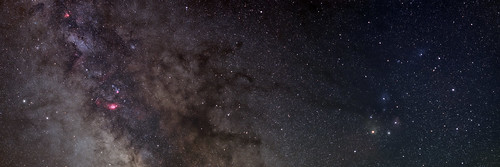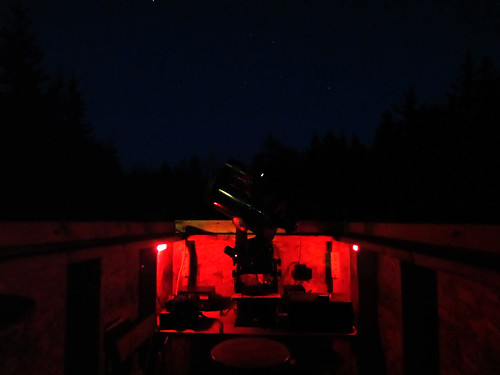The area between Sagittarius and Scorpius is littered with bright and dark nebulae, open and globular star clusters. Detailed mosaics such as these bring out the wonderous details of the region.
This image is a little tighter than my previous image as I stepped up the focal length a bit with the SMC 200mm.
Three panels, each a 45 minute exposure with a Pentax 67 and SMC 200mm f/4 lens @ f/5.6 and Kodak E200 N+1.5.
Monday, May 28, 2012
Milky Way: Three Panel Panorama
Thursday, May 24, 2012
Legacy Astrophotography: Milky Way Panorama
I've always have wanted to assemble such a photograph. In April I planned a four panel sequence that took place in the wee hours of April 28th. If made at high resolution we are looking at a 24 x 96 print.
This was the first planned mosaic of several. I have a few more coming.
Four panel panorama using a Pentax 67 and 165mm f/2.8 @ f/4.8 with Kodak E200 developed N+1.5. Each exposure 35 minutes in length. Images combined in Autostitch.
Tuesday, May 22, 2012
Monday, May 21, 2012
My Most Productive Dark-Run Ever !
This included:
A four frame east-west panorama featuring Libra through Sagittarius using the 165mm @ f/4.8 and 40 minute exposures.
Two (2) three frame east-west panoramas featuring Scorpius through Sagittarius using the 200mm @ f/5.6 and 45 minute exposures.
A two frame panorama featuring the Prancing Horse (Pipe Nebula +) and the Messier 8 region in Sagittarius using the 200mm @ f/5.6 and 45 minute exposures and another set with the 200mm @ f/6.7 and 60 minute exposures.
Three exposures of Sharpless 2-27 in Southern Ophiuchus: 30 and 40 minutes @ f/4, and 60 minutes exposure @ f/5.6
Single exposures of the constellation's Lyra, Corona Borealis, and Hercules using the 200mm @ f/4 or f/5.6 with 30 minutes exposures.
All exposures on E200 and will be pushed +1.5 stops.
 |
| The observatory on the first night of imaging during the May dark run. |
Sky conditions were above average, except for a few clouds on Friday morning during the final minutes of the last exposure.
Sky Quality Meter readings revealed sky darkness levels in the 21.56 to 21.70 mags/sq-arc-sec range on all three nights. Flirting with Bortle 2. Stars of magnitude 7.2 or fainter were seen on the last morning with only moderate effort. Brocchi's cluster appeared as a star cluster to the unaided eye and not a nebulous patch. The Pipe Nebula and other associated dark nebulae that form the "Prancing Horse" were very distinct to the unaided eye. Touring this region with 7x50 binocs was a real treat. Almost all the dark nebulae seen in photographs were visible in the binoculars. The dark streamers heading over to Rho-Oph were visible in binocs and strongly suspected to the eye alone. Simply amazing.
 |
| A little tired after the first three nights! Thankfully the equipment worked flawlessly. |
The results should be among my best work yet and the films are heading to Color Services as I write this. When I receive the films on Wednesday I will review the exposures, but I have done this long enough to know I have succeeded here, and to think I got all this done just before (nearly) the Moon turned new!
Now, to get some sorely needed sleep!
That being said, I have on the agenda for next weekend a complete tour of these same regions as captured with Acros 100. The Moon will set by midnight on both nights of the coming weekend. This is fun, like shooting fish in a barrel!
Friday, May 18, 2012
Sagittarius Milky Way
Our legacy, the Milky Way. The most organic structure in our coner of the Universe. The building blocks of complexity and everything needed to create life. It happended here, and it is likely to have happend elsewhere.
I've been photographing this region recently, this image is from August 2010. The beautiful Milky Way of Sagittarius is perhaps the most beautiful region in our Milky Way. This was a 40 minute exposure @ f/4 using the 200mm Takumar and Kodak E200 processed normally in E-6.
Thursday, May 17, 2012
Ready for the Night
The beginning a of a three night dark run at FPO. Got tomorrow off and no other agenda for the weekend.
Spring night—one hour worth
A thousand gold coins
- Basho




